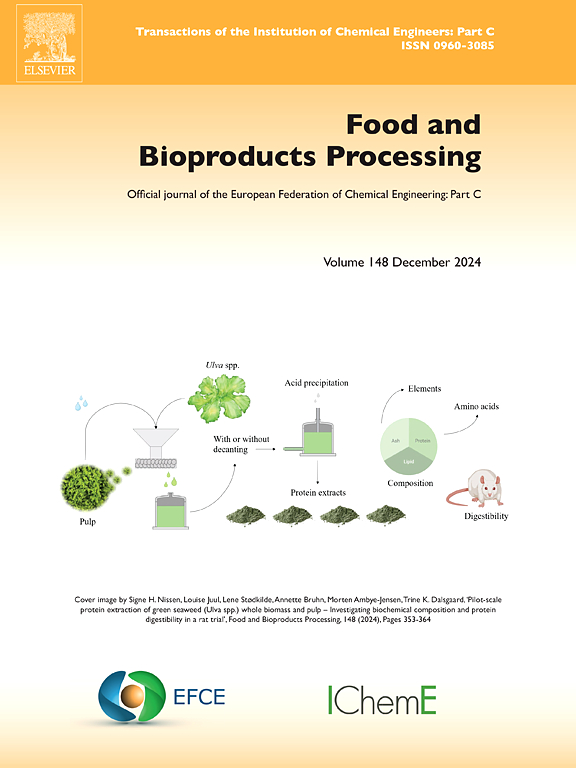Eco-efficient robusta honey coffee process for energy and water footprint reduction: A life cycle assessment
IF 3.4
2区 农林科学
Q2 BIOTECHNOLOGY & APPLIED MICROBIOLOGY
引用次数: 0
Abstract
The pulped natural/honey coffee process is an innovative, greener method for post-harvest coffee processing, integrating the best aspects of natural and washed coffee methods by extending the fermentation and drying stages, resulting in enhanced product quality correlated to conventional procedures. This study evaluated the environmental impacts of honey (HC) and washed coffee (WC) process through a life cycle perspective, focusing on water and energy footprint. The findings revealed that water consumption in the HC method was substantially reduced by 87.5 % to that of WC. HC unveiled a reduction in global warming potential (kg CO2 eq) by 94.78 %, compared to the WC process. The WC and HC water usage accounted for 98.33 % and 5.03 % of the global warming potential. Regarding ecotoxicity effects, the HC technique is a sustainable approach with insignificant impacts on marine aquatic ecotoxicity and human toxicity potential, at 5.20 % and 5.23 %. Besides, the coffee husks obtained as a by-product from the HC and WC process indicated 88.2 % and 66.9 % fermentation efficiency for bioethanol production. This study underscores the importance of environmental issues regarding food manufacturing, particularly in HC, which offers premium quality, lower water and energy consumption, and efficient by-product utilization, ultimately reducing environmental impacts throughout the technique.
生态高效的罗布斯塔蜂蜜咖啡工艺的能源和水足迹减少:生命周期评估
天然/蜂蜜纸浆咖啡工艺是一种创新的、更环保的采收后咖啡加工方法,通过延长发酵和干燥阶段,将天然和水洗咖啡方法的最佳方面整合在一起,从而提高了与传统工艺相关的产品质量。本研究从生命周期角度评估了蜂蜜(HC)和水洗咖啡(WC)工艺对环境的影响,重点关注水和能源足迹。结果表明,HC法的耗水量比WC法大幅减少87.5% %。HC公布的全球变暖潜能值(千克二氧化碳当量)减少了94.78% %,与WC过程相比。WC和HC用水量分别占全球变暖潜势的98.33 %和5.03 %。在生态毒性效应方面,HC技术是一种可持续的方法,对海洋水生生态毒性和人体毒性潜力的影响不显著,分别为5.20 %和5.23 %。此外,HC法和WC法的副产物咖啡壳发酵产乙醇的效率分别为88.2% %和66.9% %。这项研究强调了食品生产中环境问题的重要性,特别是在HC中,它提供了优质的质量,更低的水和能源消耗,以及有效的副产品利用,最终减少了整个技术对环境的影响。
本文章由计算机程序翻译,如有差异,请以英文原文为准。
求助全文
约1分钟内获得全文
求助全文
来源期刊

Food and Bioproducts Processing
工程技术-工程:化工
CiteScore
9.70
自引率
4.30%
发文量
115
审稿时长
24 days
期刊介绍:
Official Journal of the European Federation of Chemical Engineering:
Part C
FBP aims to be the principal international journal for publication of high quality, original papers in the branches of engineering and science dedicated to the safe processing of biological products. It is the only journal to exploit the synergy between biotechnology, bioprocessing and food engineering.
Papers showing how research results can be used in engineering design, and accounts of experimental or theoretical research work bringing new perspectives to established principles, highlighting unsolved problems or indicating directions for future research, are particularly welcome. Contributions that deal with new developments in equipment or processes and that can be given quantitative expression are encouraged. The journal is especially interested in papers that extend the boundaries of food and bioproducts processing.
The journal has a strong emphasis on the interface between engineering and food or bioproducts. Papers that are not likely to be published are those:
• Primarily concerned with food formulation
• That use experimental design techniques to obtain response surfaces but gain little insight from them
• That are empirical and ignore established mechanistic models, e.g., empirical drying curves
• That are primarily concerned about sensory evaluation and colour
• Concern the extraction, encapsulation and/or antioxidant activity of a specific biological material without providing insight that could be applied to a similar but different material,
• Containing only chemical analyses of biological materials.
 求助内容:
求助内容: 应助结果提醒方式:
应助结果提醒方式:


